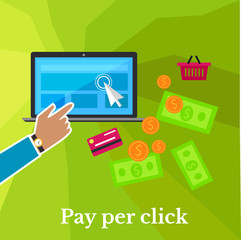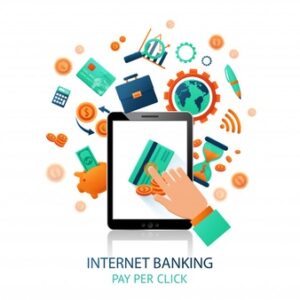PPC is a paid online advertising model in which advertisers pay a fee each time their ad is clicked. Marketers create ads and then bid on specific search phrases at the online auction. This allows them to display their ads on the search engine results page.
Every time an ad is clicked, sending the visitor to a landing page or the website, a small fee is charged. It is essentially a targeted form of buying website visits, that will hopefully end up in conversions, whether it’s a sign-up or a sale.
The different types of PPC ads include, search ads, local search ads, display ads and re-marketing. These ads can show up on web pages, social media platforms, web pages and mobile apps. They usually look similar to the content around them. For example, the ads on social media channels such as Facebook and Twitter have the same format as organic posts but are marked with “Sponsored” or “Promoted”.
PPC Keyword Research
Keyword research for PPC can be incredibly time-consuming, but it is also incredibly important. Your entire PPC campaign is built around keywords, and the most successful Google Ads advertisers continuously grow and refine their PPC keyword list. If you only do keyword research once, when you create your first campaign, you are probably missing out on hundreds of thousands of valuable, long-tail, low-cost and highly relevant keywords that could be driving traffic to your site.
An effective PPC keyword list should be:
- Relevant – Of course, you don’t want to be paying for Web traffic that has nothing to do with your business. You want to find targeted keywords that will lead to a higher PPC click-through rate, effective cost per click, and increased profits. That means the keywords you bid on should be closely related to the offerings you sell.
- Exhaustive – Your keyword research should include not only the most popular and frequently searched terms in your niche, but also to the long tail of search. Long-tail keywords are more specific and less common, but they add up to account for the majority of search-driven traffic. In addition, they are less competitive, and therefore less expensive.
- Expansive – PPC is iterative. You want to constantly refine and expand your campaigns, and create an environment in which your keyword list is constantly growing and adapting.
If you want to find high-volume, industry-specific keywords to use in your PPC campaigns, be sure to check out our popular keywords.
Managing Your PPC Campaigns
Once you’ve created your new campaigns, you’ll need to manage them regularly to make sure they continue to be effective. In fact, regular account activity is one of the best predictors of account success. You should be continuously analyzing the performance of your account and making the following adjustments to optimize your campaigns:
- Add PPC Keywords: Expand the reach of your PPC campaigns by adding keywords that are relevant to your business.
- Add Negative Keywords: Add non-converting terms as negative keywords to improve campaign relevancy and reduce wasted spend.
- Split Ad Groups: Improve click-through rate (CTR) and Quality Score by splitting up your ad groups into smaller, more relevant ad groups, which help you create more targeted ad text and landing pages.
- Review Costly PPC Keywords: Review expensive, under-performing keywords and shut them off if necessary.
- Refine Landing Pages: Modify the content and calls-to-action (CTAs) of your landing pages to align with individual search queries in order to boost conversion rates. Don’t send all your traffic to the same page.
How Does It Work?
In Pay-Per-Click advertising, ads are subject to a bidding system known as the Ad Auction. It’s an automated process followed by major search engines to determine the validity and relevance of the ads that appear on their search engines results page
At the auction, advertisers bid on keywords that are relevant to their business. These are search terms they want to “trigger,” or display, their ads. For example, if your business sells camping, you will want to bid on the keyword, “best sleeping bags”.
Use keyword search tools to find relevant keywords with the right volume and the average cost per click.
Once you have the relevant keywords, create an ad and set it up in the search engine platform. Add the keywords that you want the ads to trigger for.
Set the bids for how high up in the ad section of the search results their ad will show. Apart from bid price, the advertising platform also looks at factors such as quality score and ad extensions to determine which ad is suited for the highest position. For example, the quality score sums up the quality of your ad based on ad relevance, landing page experience and click-through-rate.
When a user submits the search query, there’s a complex algorithmic calculation done by the search engine which is based on the Ad Auction. The results of these calculations determine the ads that are displayed, their order and by which advertiser.
In a PPC campaign, you pay Google however much you wish to have them list ads for your site at the top and right of the organic search listings. When someone clicks on your ad, you pay the current Cost Per Click (CPC) from your budget. Once your entire budget has been depleted, Google ceases to run your ads until you replenish your fund. There are several different types of Google Ads, including: Search Ads, Local Search Ads, Display Ads, and Remarketing.
Search Ads
Google Search Ads are perhaps the most commonly recognized form of pay-per-click advertisements. These ads are displayed above or beside Google search results in response to what a user searches. So, if someone searches for the product or service you offer, your ad can be the first thing they see; but, through the PPC model, you only have to pay when they click on that ad.
Local Search Ads
Local Search Ads are not a separate type of PPC advertisement; rather, they are a specialized subset of the standard Search Ads. These location focused ads can target users searching for businesses or services near yours on Google or Google Maps. Like Search Ads, they are charged on a cost-per-click basis
Display Network
The Google Display Ad is not an exact pay-per-click model, but it is a similar process and reaches a broad audience. These ads can be text based, or media rich banners, and can be developed to display across any of more than two million websites and 650,000 apps. The setup process is streamlined, so you simply have to create your ad to fit your chosen format, choose which audiences you would like to reach, and then determine your budget. Finally, you can choose from among a variety of payment options, depending upon your goal for the campaign; these include: cost-per-click (CPC,) cost-per-thousand-impression (CPM,) and cost-per-acquisition (CPA.)
Pre-Roll Ads
Pre-roll ads are the most common form of video advertisement, and one we’re sure you likely encounter every day. You find a YouTube video you want to watch (tutorial, review, etc.) but right before the video begins, there’s an ad that plays. There are also “mid-roll” and “post-roll ads” (sole difference being when the ads appear as it relates to the video you clicked to watch.) These can be targeted by Geo-location, native language, demographics, topics, and interests.
Re-marketing or Retargeting
Remarketing Ads are shown to people who have visited your business’s website or mobile app in the past. These ads can help you reconnect with visitors who have expressed interest in your products or services in the past, and can help to encourage conversions. These ads can be shown on the Display Network or as Search Ads, and are priced on a automatic bidding model. There are a few extra steps to set up, but it may be worth the dramatically increased click through and conversion rates to narrow your ad audience to those who have already made a connection with your business.
Why Should You Use Pay-Per-Click?
There are many compelling benefits of pay-per-click advertising:
- PPC is measurable and trackable. You can see how your campaigns are performing, including impressions, clicks, and conversions, the traffic you’re receiving and how the results correlate to your budget
- It provides a better understanding of the behavior and search patterns of the customers
- Unlike SEO, PPC allows you to quickly set up campaigns, create ads and find new customers and prospects
- You get budget flexibility. You can set up your ad budget and choose how much you want to spend. For example, if you see positive results, you can scale up quickly
- You get a wealth of targeting options, whether you want to target keywords through search ads or focus on a specific demographic on the display network
- Your ads work on all platforms, including mobile and desktop devices
0 Comments